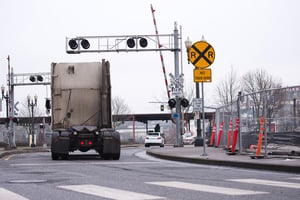Side-impact collisions between a semi-truck and train can result in devastating losses. The key to preventing a crash is to be able to recognize the hazards that can lead to a collision and take appropriate defensive measures. Read the information below and ask yourself if there are actions you can take to improve your driving skills and reduce the risk of a crash at a railroad crossing.
RECOGNIZE THE HAZARDS
ENVIRONMENT
Railroad crossings create unique hazards for truck drivers. The width of the crossing and the grade/slope of the road leading up to the tracks can make startups challenging. Missing or inoperable warning signs, as well as obstructions, adverse weather, and poor lighting, can make an approaching train challenging to spot.
EQUIPMENT
If the trailer’s landing gear is not fully raised or if pulling a lowboy-type trailer with low ground clearance, the trailer could get stuck on the tracks and prevent the driver from moving the truck and avoiding an oncoming train.
PERSONAL BEHAVIORS
Crashes at railroad crossings can result from a driver’s poor judgment (i.e., misjudging the approaching train’s speed), impatience (i.e., trying to beat the train), stopping or getting stuck on the tracks, or stopping too close to the tracks and being unaware of the train’s width.
KNOW THE DEFENSE
QUICK TIPS
- Crank the trailer’s landing gear up entirely before driving.
- Refer to 49 CFR Part 392.10-11 and 383.51 (Table 3) for railroad crossing regulations.
- Visit the Operation Lifesaver website oli.org for additional safety trips for truck drivers.
CROSSING PROCEDURES
If a railroad crossing has missing or inoperable warning signs/crossing arms:
- Approach with caution and stop within 15 feet but not more than 50 feet from the nearest rail.
- Turn ON the four-way flashers and turn OFF all devices (i.e., radio, air conditioner, etc.).
- Roll down the windows and look in both directions for an approaching train.
When it is safe to cross:
- Do not cross until there is room on the opposite side of the tracks to fit the entire length of your truck.
- Cross the tracks using the highest gear that will let you cross all the tracks without shifting gears.
- NEVER stop on the tracks.
EMERGENCY PROCEDURES
If the truck stalls or gets hung up on the tracks:
- Get out of the truck and move to a safe location.
- Call 911 immediately and notify law enforcement of the crossing’s identification number.
If a train is approaching:
- Run in the direction of the oncoming train at a 45-degree angle away from the tracks.
Note: These lists are not intended to be all-inclusive.

